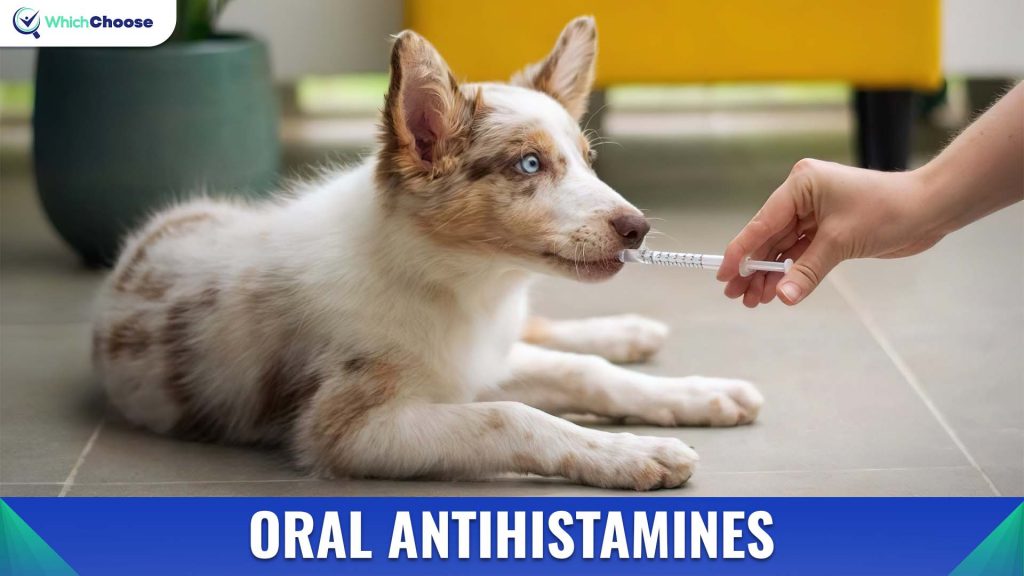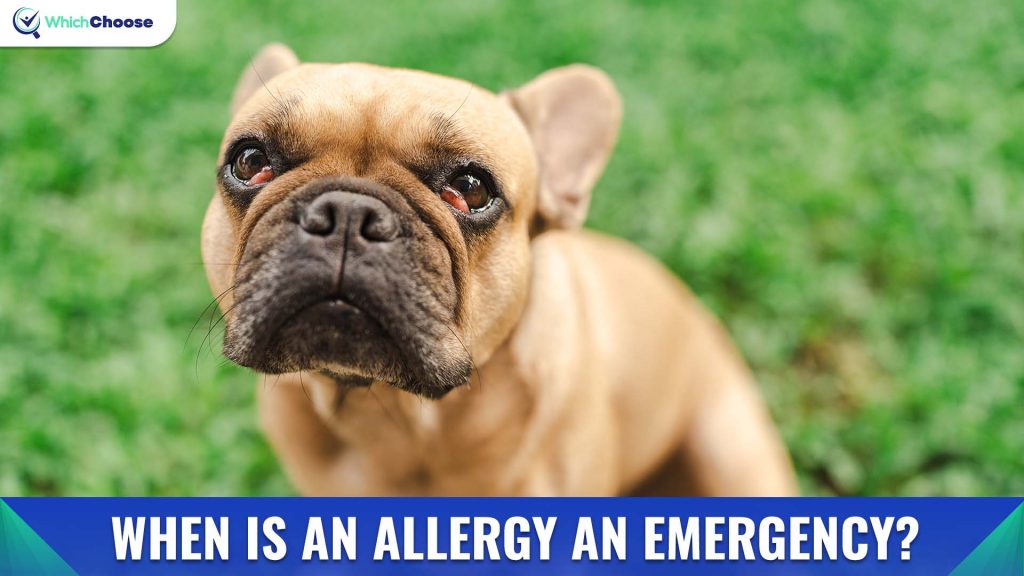Table of Contents
For many dogs, allergies are a common issue. It does not mean they have to live with it for a lifetime. You can try some things to reduce the symptoms of allergies. This blog from WhichChoose lists some things to help answer this question: What can I give my dog for allergies?

What Are Symptoms of Allergies in Dogs?
There are a few common allergic reactions that your dog may experience:
- Wheezing.
- Vomiting.
- Sneezing.
- Frequent ear infections.
- Itching (usually in “hot spots” on the body).
- Frequent paw-licking and chewing.
- Runny eyes and nose.
- Coughing.
- Diarrhea.
What Can I Give My Dog For Allergies?
2.1. Oral Antihistamines (Benadryl, Claritin, or Zyrtec)
Benadryl is the most common oral antihistamine for dogs with mild to moderate allergies. Alternatives to Benedryl [1] include the allergy medications Claritin and Zyrtec. You may have heard that the same oral antihistamines you take to treat your allergic reactions [2] can be given to your dog. While this may be true, our furry pals require a different dosage and are more susceptible to other risks.
Consult your vet about the proper dosage of an oral antihistamine before giving it to your dog for the first time. After getting the all-clear, keep an eye out for signs of unusual drowsiness or hyperactivity in your dog. If allergy symptoms persist, you should schedule an appointment with the vet.

2.2. Prescription Medications
Some allergy symptoms in dogs may outgrow over-the-counter medications or acquire problems they cannot handle. Prescription drugs from your vet are the last resort. They are stronger than over-the-counter allergy supplements and can help dogs with severe allergies.
These medications are usually topical, oral, or allergy injections [3]. Your vet will assess your dog’s allergies before prescribing medication.
2.3. Omega-3s
Omega-3 fatty acids [4] in supplement form can help your dog cope with allergic reactions. They are essential fatty acids that benefit you and your dog.
Certain Omega-3 fatty acids can reduce inflammation in your dog. Eicosapentaenoic acid (EPA), eicosapentaenoic acid (ETA), and stearidonic acid [5] (SDA) are all examples of these. Because they are anti-inflammatory, they can help with the itching and scratching that allergies can cause.
The most well-known brand, Reggie, is rich in Omega 3 and can help reduce your dog’s allergic symptoms. You can see the review here before making decision.
Reggie Dog Supplements
2.4. Natural Remedies
May dog parents will concern: “What can I give my dog for allergies at home?” The answer is using natural remedies. It is a convenient way to reduce dog allergies. Many “natural” remedies for itchy skin and allergies include quercetin, bromelain, yucca, and coconut oil.
While aloe vera and oatmeal have also been demonstrated to help soothe skin irritation in dogs [6], it is important to see your vet before trying either of these at home.
2.5. Probiotics
Whenever people discuss allergy supplements, probiotics inevitably come up. Even though they won’t “cure” your dog’s allergies, they may help mitigate symptoms and keep the rest of their body in good shape as they fend off the allergens. Bear in mind that you should never give your dog probiotics intended for humans because they need to be dog-specific.
2.6. Topicals
Stop wondering “What can I give my dog for allergies and itching?” Topical treatments can effectively alleviate your dog’s allergy symptoms. This basic version will do the trick if you can’t give your dog an oral or injectable anti-inflammatory. Common topical ingredients include chlorhexidine, ketoconazole, aloe vera, and vitamin E. Also, the pleasant smell of some topical treatments might help your dog relax and calm down.
Balms and sprays are two examples of topical medications. In addition to relieving itching and inflammation, they can help heal cuts, burns, surgical wounds, mange, and other skin infections and irritations caused by bacteria. Lavender, chamomile, frankincense, cocoa butter, and vitamin E are some of the vital elements in organic and vegan balms.
When Is An Allergy an Emergency?

Your dog could go into life-threatening anaphylactic shock if they have a severe allergic reaction to something they’ve eaten or been stung by.
Watch out for these signs and get your pet to the vet right away if you spot any of them:
- Excessive drooling.
- Swollen face.
- Bluish tongue or gums.
- Difficulty breathing.
- Sudden diarrhea.
What can I give my dog for allergies? Have you answered that question yet? Your dog will no longer suffer from skin irritations and itchy paws if you follow these tips from WhichChoose whenever he has seasonal allergies or anything else. However, if your dog’s allergies keep getting worse, bring your dog to a vet immediately.
Trusted Sources:
- [1] Banovic, Frane; Denley, Tara; Blubaugh, Amanda; Scheibe, Ileia; Lemo, Niksa; Papich, Mark G. (2020). Effect of diphenhydramine and cetirizine on immediate and late phase cutaneous allergic reactions in healthy dogs: a randomized, double‐blinded crossover study. Veterinary Dermatology, vde.12840–. doi:10.1111/vde.12840.
- [2] J G Jeffers, E K Meyer, E J Sosis. Responses of dogs with food allergies to single-ingredient dietary provocation. J Am Vet Med Assoc. 1996 Aug 1;209(3):608-11. Available at https://pubmed.ncbi.nlm.nih.gov/8755979/.
- [3] Åberg, Liselotte; Varjonen, Katarina; Åhman, Susanne (2017). Results of allergen-specific immunotherapy in atopic dogs with <i>Malassezia</i> hypersensitivity: a retrospective study of 16 cases. Veterinary Dermatology, (), –. doi:10.1111/vde.12475.
- [4] R. S. Mueller; K. V. Fieseler; M. J. Fettman; S. Zabel; R. A. W. Rosychuk; G. K. Ogilvie; T. L. Greenwalt (2004). Effect of omega-3 fatty acids on canine atopic dermatitis. , 45(6), 293–297. doi:10.1111/j.1748-5827.2004.tb00238.x.
- [5] Herbert Fuhrmann, Annett Zimmermann, Thomas Gück, and Gerhard Oechtering. Erythrocyte and plasma fatty acid patterns in dogs with atopic dermatitis and healthy dogs in the same household. Can J Vet Res. 2006 Jul; 70(3): 191–196. Available at https://www.ncbi.nlm.nih.gov/pmc/articles/PMC1477930/.
- [6] Harvey, Naomi D.; Craigon, Peter J.; Shaw, Stephen C.; Blott, Sarah C.; England, Gary C.W. (2019). Behavioural Differences in Dogs with Atopic Dermatitis Suggest Stress Could Be a Significant Problem Associated with Chronic Pruritus. Animals, 9(10), 813–. doi:10.3390/ani9100813.
WhichChoose is the website products and services review that helps users in the world to find what the best is and shop easily.







